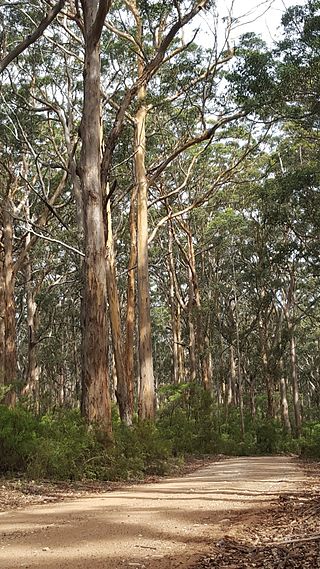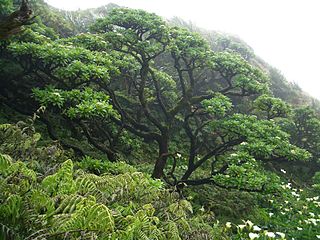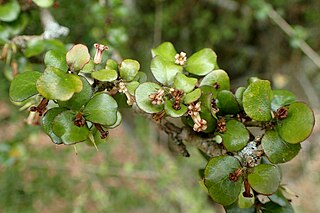
Eucalyptus diversicolor, commonly known as karri, is a species of flowering plant in the family Myrtaceae and is endemic to the south-west of Western Australia. It is a tall tree with smooth light grey to cream-coloured, often mottled bark, lance-shaped adult leaves and barrel-shaped fruit. Found in higher rainfall areas, karri is commercially important for its timber.

The Saint Helena scrub and woodlands ecoregion covers the volcanic island of Saint Helena in the South Atlantic Ocean. The island's remote location gave rise to many endemic species. First discovered and settled in the 1500s, the island has been degraded by human activities. Most of its native habitat has been destroyed, and many of its unique plants and animals are extinct or endangered.

Pittosporum resiniferum, the resin cheesewood or petroleum nut, is a tree that grows in the Philippines and Malaysia, particularly in the wilderness surrounding the Mayon Volcano and in the Cordillera of the Philippines and Mount Kinabalu of Sabah, Malaysia. The petroleum nut derives its name from the resemblance of the fruit's odor to petroleum-based fuels. The fruits of the tree burn brightly when ignited, and can be used for illumination as torches or candles. Its fruit is also highly suitable for use in producing biofuel. This use has been encouraged by the Philippines Department of Agrarian Reform and the Philippine Coconut Authority.

Pittosporum is a genus of about 250 species of flowering plants in the family Pittosporaceae. Plants in the genus Pittosporum are shrubs or trees with leaves arranged alternately along the stems. The flowers are arranged singly or in cymes, with white to yellow petals fused at the base forming a short tube, with stamens that are free from each other. The fruit is a capsule with a single locule that opens to reveal angular seeds.

Pittosporum crassifolium, karo, stiffleaf cheesewood, kaikaro or kihiki is a relatively fast-growing large shrub or small tree with an erect, fastigiate growth habit. It is native to New Zealand.

Hymenosporum is a monotypic genus of trees in the family Pittosporaceae. The sole included species is Hymenosporum flavum, commonly known as native frangipani, found in the rainforests and wet sclerophyll forests of New Guinea, Queensland and New South Wales. Despite its common name, it is not closely related to the frangipani, but is related to the widespread genus Pittosporum.

Pittosporum tenuifolium is a small evergreen tree endemic to New Zealand – growing up to 10 m (33 ft) – commonly known as kōhūhū and black matipo, and by other Māori names kohukohu and tawhiwhi. Its small, very dark, reddish-purple flowers generally go unnoticed, and are scented only at night. The Latin tenuifolium means "slender-leaved"

Pittosporum undulatum is a fast-growing tree in the family Pittosporaceae. It is sometimes also known as sweet pittosporum, native daphne, Australian cheesewood, Victorian box or mock orange.

Pittosporum obcordatum, commonly called heart-leaved kohuhu or heart-leaved kohukohu or kohukohu, is a species of plant in the Pittosporaceae family. It is endemic to New Zealand, and is found both in the North Island and the South Island.

Pittosporum eugenioides, common names lemonwood or tarata, is a species of New Zealand native evergreen tree. Growing to 12 m (39 ft) tall by 5 m (16 ft) broad, it is conical when young but more rounded in shape when mature. Its leaves are mottled yellow-green with curly edges and a salient bright midrib, and have a strong lemony smell when crushed. It has highly fragrant clusters of attractive yellow-cream flowers in spring, followed by distinctive black seed capsules. It is found throughout New Zealand's North and South Islands along forest margins and stream banks from sea level to 600 m (1,969 ft). It is New Zealand's largest Pittosporum.

Pittosporum tobira is a species of sweet-smelling flowering plant in the pittosporum family Pittosporaceae known by several common names, including Australian laurel, Japanese pittosporum, mock orange and Japanese cheesewood. It is native to Japan, China, Taiwan, and Korea, but it is used throughout the world as an ornamental plant in landscaping and as cut foliage.
Victoria, Australia contains approximately 32,000 hectares of temperate rainforest in various regions, which represents 0.14% of the State's total area. The areas with rainforest include: East Gippsland, Strzelecki Ranges, Wilsons Promontory, Central Highlands, and Otway Ranges. The rainforests vary between cool temperate, warm temperate, and mixed cool temperate.

Pittosporum bicolor, commonly known as cheesewood or banyalla, is a flowering shrub or small tree of the family Pittosporaceae, and is native to south eastern Australia.

Southern Afrotemperate Forest is a kind of tall, shady, multilayered indigenous South African forest. This is the main forest-type in the south-western part of South Africa, naturally extending from the Cape Peninsula in the west, as far as Port Elizabeth in the east. In this range, it usually occurs in small forest pockets, surrounded by fynbos vegetation.

Coprosma lucida, commonly known as shining karamu, karamū, kāramuramu, shiny karamu, or kakaramu, is a shrub or tree endemic to New Zealand.

Empisini Nature Reserve was established in 1973 and is situated in Umkomaas, KwaZulu-Natal, South Africa. The reserve is approximately 60 ha in extent and is owned by the borough of uMkhomanzi which has been incorporated into the eThekwini municipality. Empisini is managed jointly by eThekwini and the Umkomaas centre of the Wildlife and Environment Society of South Africa. Empisini takes its name from a perennial stream which flows through it, and means "Place of the Hyena" in isiZulu. The reserve consists of coastal forest, wetlands, grassy slopes and a dam. Infrastructure consists of hiking trails, demarcated picnic sites, overnight cabins, and a tree house.

Drypetes gerrardii is a species of small tree or large shrub in the family Putranjivaceae. Common names include forest ironplum, bastard white ironwood, and forest ironwood. It is native to tropical and subtropical central and eastern Africa. It was first described in 1920 by the English botanist John Hutchinson, who named it after the English botanist William Tyrer Gerrard who collected plants and seeds in southern Africa in the 1860s.

Pittosporum ferrugineum, commonly known as the rusty pittosporum or rusty-leaved pittosporum, is an evergreen plant in the family Pittosporaceae native to Malesia, Papuasia, the Northern Territory and Queensland.

Pittosporum hosmeri, also referred to as Kona cheesewood, ʻaʻawa, or ʻaʻawa hua kukui, is a cheesewood endemic to the island of Hawai'i. It is a species of tree in the Pittosporaceae family. This species is listed as endangered and are endemic to the islands. Like other members of the genus native to Hawai'i, it is also referred to as Hō'awa or Hāʻawa in the Hawaiian language.


















